The impact analysis of a mixed squadron, containing LCS and multi-mission surface platforms, on Blue force casualties and mission effectiveness
| dc.contributor.advisor | Lucas, Thomas W. | |
| dc.contributor.author | Milliken, Michael S. | |
| dc.date.accessioned | 2012-03-14T17:39:52Z | |
| dc.date.available | 2012-03-14T17:39:52Z | |
| dc.date.issued | 2008-09 | |
| dc.identifier.uri | https://hdl.handle.net/10945/3949 | |
| dc.description.abstract | In today's world, the United States is the dominant naval power. World powers are trading naval dominance in favor of naval defense, creating fleets of smaller ships to protect their littoral waters. As a result, the United States Navy will be called upon to engage enemy naval forces to ensure access against asymmetrical threats close to enemy coastlines. The Littoral Combat Ship (LCS) is a networked, focused-mission platform, designed to be swift, agile, stealthy, and capable of defeating asymmetric threats in the littorals. Although the LCS has limited capability to handle simultaneous missions, it will not be alone. The experimental guided missile destroyer DD(X) is the U.S. Navy's next-generation; multimission, surface combatant tailored for land attack and littoral dominance, with capabilities designed to defeat current and projected threats. Through simulation, data analysis and design of experiment, this model simulated 15,420 littoral battles to determine if the addition of a multimission platform to an LCS squadron affected overall Blue force casualties and mission effectiveness. The study examined squadron composition, size, and effects of sensors and weapon systems in both a Surface Warfare (SUW) and Anti-Air Warfare (AAW) scenario. The data analysis revealed that a squadron composition of 5 to 11 LCSs with 1 to 2 DDGs in an SUW scenario provided the best outcomes, while Destroyers and aircraft had the most impact for AAW missions. | en_US |
| dc.description.uri | http://archive.org/details/theimpactnalysis109453949 | |
| dc.format.extent | xxvi, 95 p. : ill. ; | en_US |
| dc.publisher | Monterey, California. Naval Postgraduate School | en_US |
| dc.rights | This publication is a work of the U.S. Government as defined in Title 17, United States Code, Section 101. Copyright protection is not available for this work in the United States. | en_US |
| dc.subject.lcsh | Littoral combat ships | en_US |
| dc.subject.lcsh | United States | en_US |
| dc.subject.lcsh | Destroyers (Warships) | en_US |
| dc.subject.lcsh | Warships | en_US |
| dc.subject.lcsh | Unified operations (Military science) | en_US |
| dc.subject.lcsh | Anti-submarine warfare | en_US |
| dc.subject.lcsh | Technological innovations | en_US |
| dc.subject.lcsh | Submarine mines | en_US |
| dc.subject.lcsh | Detection | en_US |
| dc.subject.lcsh | Coast defenses | en_US |
| dc.subject.lcsh | United | en_US |
| dc.subject.lcsh | States | en_US |
| dc.title | The impact analysis of a mixed squadron, containing LCS and multi-mission surface platforms, on Blue force casualties and mission effectiveness | en_US |
| dc.type | Thesis | en_US |
| dc.contributor.secondreader | Lesnowicz, Edward J. | |
| dc.contributor.corporate | Naval Postgraduate School (U.S.) | |
| dc.description.service | US Navy (USN) author. | en_US |
| dc.identifier.oclc | 268958664 | |
| etd.thesisdegree.name | M.S. | en_US |
| etd.thesisdegree.level | Masters | en_US |
| etd.thesisdegree.discipline | Modeling, Virtual Environments, and Simulation Institute (MOVES) | en_US |
| etd.thesisdegree.grantor | Naval Postgraduate School | en_US |
| etd.verified | no | en_US |
| dc.description.distributionstatement | Approved for public release; distribution is unlimited. | |
| dc.description.distributionstatement | Approved for public release; distribution is unlimited. |
Files in this item
This item appears in the following Collection(s)
-
1. Thesis and Dissertation Collection, all items
Publicly releasable NPS Theses, Dissertations, MBA Professional Reports, Joint Applied Projects, Systems Engineering Project Reports and other NPS degree-earning written works.





